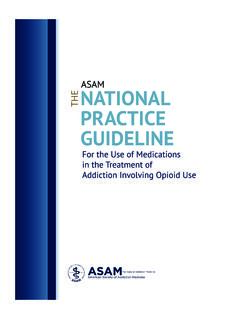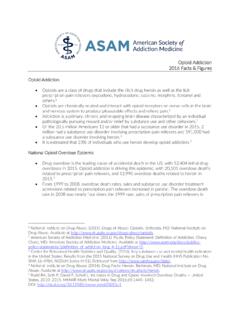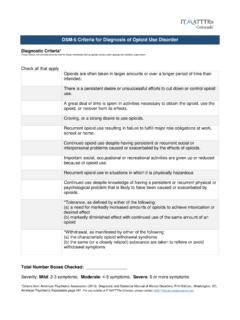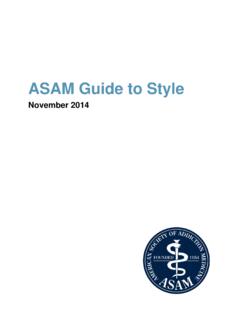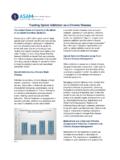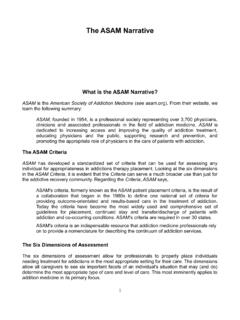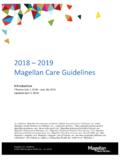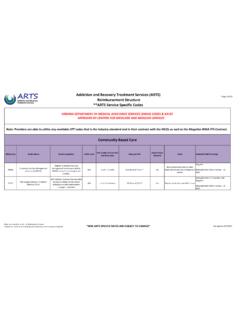Transcription of The ASAM Clinical Practice Guideline on Alcohol
1 Downloadedfrom BhDMf5ePHKav1zEoum1tQfN4a+kJLhEZgbsIHo4 XMi0hCywCX1 AWnYQp/IlQrHD3 RQIKUrpuF//+TLr8jGhDY87 TpJTbZN0FK3a045zhsAU=on 06/04/2020 Downloadedfrom BhDMf5ePHKav1zEoum1tQfN4a+kJLhEZgbsIHo4 XMi0hCywCX1 AWnYQp/IlQrHD3 RQIKUrpuF//+TLr8jGhDY87 TpJTbZN0FK3a045zhsAU=on 06/04/2020 Copyright 2020 American Society of Addiction Medicine. Unauthorized reproduction of this article is ASAM Clinical Practice Guideline on AlcoholWithdrawal ManagementGuideline Committee Members(alpha order):Anika Alvanzo, MD, MS, DFASAM, FACPKurt Kleinschmidt, MD, FASAMJ ulie A. Kmiec, DO, FASAMG eorge Kolodner, MD, DLFAPA, FASAMG erald E. Marti, MD, PhDWilliam F. Murphy, DO, MS, DFASAMC arlos F. Tirado, MD, FASAMC orey Waller, MD, MS, DFASAM, FACEPL ewis S.
2 Nelson, MD, FASAM, FACEP, FACMT(Chair) Clinical Champions(alpha order):Stephen Holt, MD, MS, FACPD arius Rastegar, MD, FASAMR ichard Saitz, MD, MPH, FACP, DFASAMM ichael F. Weaver, MD, DFASAMASAM Quality Improvement Council (alpha order):John Femino, MD, DFASAMK enneth Freedman, MD, DFASAM(Chair)R. Jeffrey Goldsmith, MD, DLFAPA, DFASAMB arbara Herbert, MD, DFASAM(Past- Chair)Margaret Jarvis, MD, DFASAMM argaret M. Kotz, DO, DFASAMP. Stephen Novack, DODavid R. Pating, MDSandrine Pirard, MD, PhD, MPH, FAPA, FASAMASAM Staff:Maureen Boyle, PhD, Chief Quality and Science OfficerLeah White, MPH, Director of Quality ImprovementTaleen Safarian, Manager of Science and DisseminationInstitute for Research Education and Training in Addic-tions (IRETA) Team Members:Dawn Lindsay, PhD, Project DirectorJessica Williams, MPH, Assistant Project DirectorPiper Lincoln, MS, Senior Research AssociateJackie Jones, MS, Research AssociateRachael Vargo, BA, Research AssociatePeter F.
3 Luongo, PhD, Executive DirectorASAM is honored that this Clinical Practice Guideline hasbeen endorsed by:American College of Preventive MedicineAmerican Osteopathic Academy of Addiction MedicineFederation of State Physician Health ProgramsNational Association of Addiction treatment ProvidersNational Association of Clinical Nurse SpecialistsNational Commission on Correctional Health CareTable of ContentsGlossary of Terms2 Abbreviations and Acronyms3 Executive Summary3 Introduction15I. Purpose15II. Background15 III. Scope of Guideline16IV. Intended Audience16V. Qualifying Statement16VI. Special Terms16 Approach and Methodology17I. Overview of Approach17II. Develop the Scope and Key Questions18 III. Conduct a Literature Review18IV.
4 Develop Draft Guideline Statements19V. Conduct Panel Ratings19VI. Drafting the Guideline Document20 Recommendations20I. Identification and Diagnosis of Alcohol Withdrawal20A. Identification20B. Diagnosis21C. Differential Diagnosis21II. Initial Assessment of Alcohol Withdrawal23A. General Approach23B. Risk Factors for Severe or Complicated Withdrawal24C. Risk Assessment Tools25D. Symptom Assessment Scales26E. Identify Concurrent Conditions27 III. Level of Care Determination28A. General Approach28B. Level of Care Determination Tools28C. Considerations for Ambulatory vs Inpatient Management29IV. Ambulatory Management of Alcohol Withdrawal33A. Monitoring33B. Supportive Care35C. AUD treatment Initiation and Engagement36D.
5 Pharmacotherapy36V. Inpatient Management of Alcohol Withdrawal43A. Monitoring43B. Supportive Care44C. AUD treatment Initiation and Engagement45D. Pharmacotherapy45VI. Addressing Complicated Alcohol Withdrawal50A. Alcohol Withdrawal Seizure50B. Alcohol Withdrawal Delirium51C. Alcohol -Induced Psychotic Disorder53D. Resistant Alcohol Withdrawal53 VII. Specific Settings and Populations54A. Primary Care54B. Emergency Departments55C. Hospitalized Patients56D. Patients with Medical Conditions58E. Patients who Take Opioids58F. Patients who are Pregnant58 Areas for Further Research59 Appendices61I. Cited References61II. Literature Search Methods66A. Empirical Literature Search Terms66B. Gray Literature Search66 Adopted by the asam Board of Directors January 23, 20201 CLINICALPRACTICEGUIDELINEC opyright 2020 American Society of Addiction Medicine.
6 Unauthorized reproduction of this article is OF TERMSB elow are terms that are used throughout the that some terms listed below are used to convey aspecific meaning for the purposes of this Guideline ( , clinicians ).Abstinence:Intentional and consistent restraint fromthe pathological pursuit of reward and/or relief that involvesthe use of substances and other behaviors. These behaviorsmay involve, but are not necessarily limited to substance use,gambling, video gaming, or compulsive sexual behaviors. Useof FDA approved medications for the treatment of substanceuse disorder is consistent with Specialist Physician:Addiction specialistphysicians include addiction medicine physicians and addic-tion psychiatrists who hold either a subspecialty board certi-fication in addiction medicine by the American Board ofPreventative Medicine, a board certification in addictionmedicine from the American Board of Addiction Medicine,a subspecialty board certification in addiction psychiatryfrom the American Board of Psychiatry and Neurology, asubspecialty board certification in addiction medicinefrom the American Osteopathic Association, or certificationin addiction medicine from the American Society of Addic-tion therapy (see also monotherapy).
7 A pharma-ceutical drug used together with a primary pharmaceuticaldrug whose purpose is to assist the primary Hallucinosis/ Alcohol -induced Psychotic Dis-order:See Special Terms on page criteria dimensions: the asam Criteriausesix dimensions to define a holistic biopsychosocial assess-ment of an individual to be used for service and treatmentplanning including acute intoxication or withdrawal potential;biomedical conditions and complications; emotional, behav-ioral, or cognitive conditions or complications; readiness forchange; continued use or continued problem potential; andrecovery/living :The Clinical Institute Withdrawal Assess-ment of Alcohol Scale, Revised, is a reliable, valid, andreproducible severity of Alcohol withdrawal in communicativepatients once a diagnosis has been Alcohol withdrawal:See Special Termson page (Healthcare providers):Used throughoutthe Guideline , this term is intentionally broad.
8 It encompassesanyone who participates in providing care to patients withsubstance use disorders, including staff at specialty addictiontreatment centers or other healthcare settings that providesubstance use disorder :See Special Terms on page loading:See Special Terms on page agents:Drugs that affect the neurotrans-mitter GABA or its receptors. These include agonists, antag-onists, modulators, reuptake inhibitors and include benzodiazepines, phenobarbital, and Withdrawal Management:See SpecialTerms on page :The relationship between repeated episodesof Alcohol withdrawal which become progressively moresevere is referred to as the kindling effect or is theorized to be the result of increased neuronalexcitability and sensitivity with repeated episodes of with-drawal and has been demonstrated to result in increasedcraving for Alcohol and decreased responsiveness to treatmentwith 7 Level of Care:See Special Terms on page (see also adjunct therapy):The use of asingle drug to treat a disorder or.
9 Used throughout the Guideline , this term isintentionally broad. It encompasses anyone who receives carefor a Substance Use Disorder (SUD) in a specialty SUDtreatment center or other healthcare :Therapy (medical treatment ) usingpharmaceutical capital:The breadth and depth of internaland external resources that can be drawn upon to initiate andsustain recovery from Alcohol and other drug problems. It canbe found at the personal, social, community and culturallevels. Examples of recovery capital include physical health,financial assets, supportive social relationships, visible localrecovery role models, and accessible/affordable use:Used instead of drug use or drugand Alcohol use, this term refers to the use of psychotropicsubstances, which may include illegal drugs, medications oralcohol.
10 This does not refer to Use Disorder (SUD):Substance use disor-der is marked by a cluster of cognitive, behavioral, andphysiological symptoms indicating that the individual con-tinues to use Alcohol , nicotine, and/or other drugs despitesignificant related problems. Diagnostic criteria are given inthe DSM-5. Substance use disorder is the new nomenclaturefor what was included as substance dependence and substanceabuse in the PRISMA Flow Diagram67D. Reasons for Exclusion68 III. Alcohol Withdrawal Scales Table68IV. Flowcharts (Supplemental Digital Content, )70V. Sample Medication Regimens70VI. Statement Rating Table (Supplemental Digital Content, )70 VII. Disclosures and Conflicts of Interest70A.
